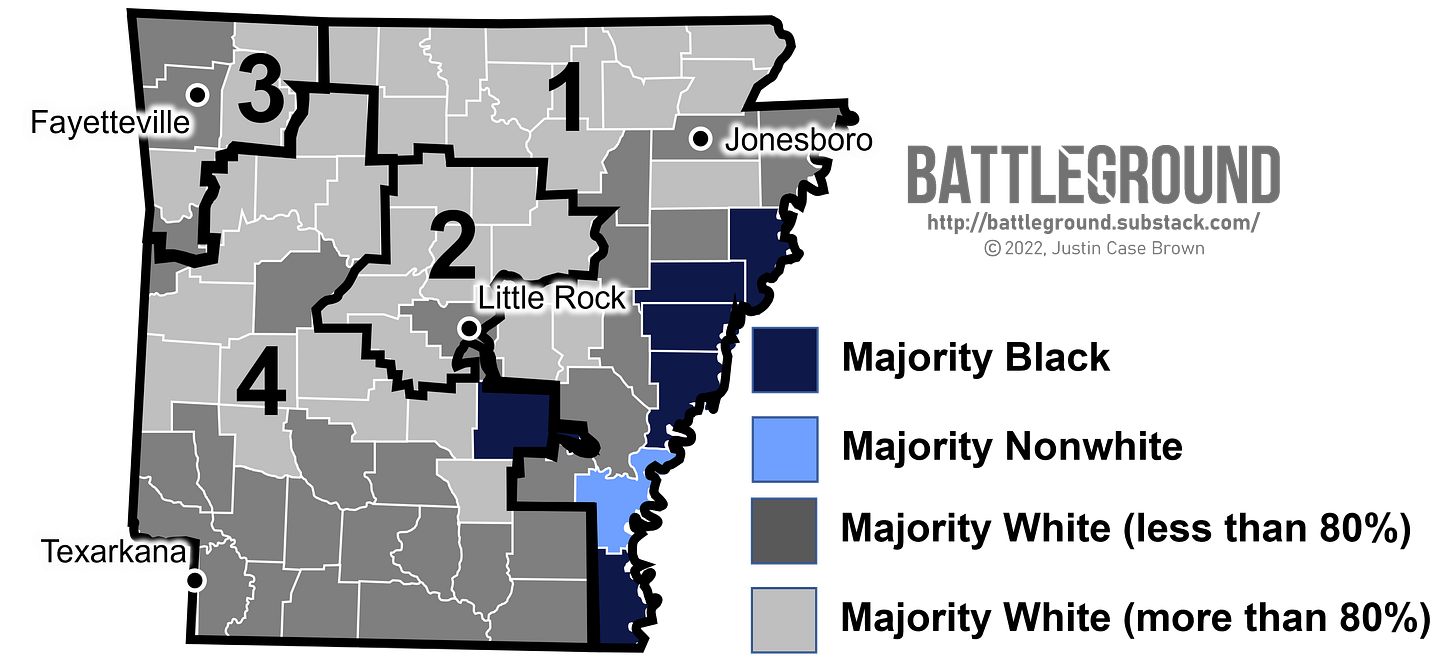Arkansas: Still Segregated
The state's Black voting population was split across several districts despite being concentrated in the southeastern corner of the state.
Topline Takeaways
Republicans hold majorities in both state houses, giving them complete control over the state’s redistricting process.
The state’s districts saw few changes and no seats are expect to change parties following the 2022 midterm elections.
Racial gerrymandering lawsuits have been filed due to the way the new districts dilute the minority vote with the way it splits the state’s most populous county across three districts.
Who’s In Control
In Arkansas, Republicans hold majorities in both state houses, allowing them to hold complete control over the state’s redistricting process. The legislature passed new districts in early October. Days later, the state’s governor (also a Republican) announced that he would not sign, nor veto the new districts, resulting in a delay. They were finally enacted into law in January 2022.
District Breakdown
Mapmakers made minor changes to the state’s old congressional districts. AR-3 has shrunk down to only hold Northwest Arkansas as this area is one of the fastest growing regions in the United States. (The region’s population doubled between 1990 and 2010.) AR-1 and AR-4 expanded to take over the counties that were dropped out of AR-3. To Republicans’ chagrin, the lack of significant changes is what has put the state’s new congressional districts under the microscope.
Arkansas is still racially segregated on a north-south axis. The majority of counties north of Little Rock are over 90% white; most of the counties south of the city are no more than 70% white. The state also has six majority-Black counties and nearly all of them fall along the Mississippi River. With most of the state’s Black population living in a concentrated area, it’s hard to not see the minority-majority district staring you in the face. Instead, Republicans chose to once again wrap the state’s most racially segregated counties into a single district, ultimately giving White voters in Northern Arkansas an edge over the more reliably Democratic Black voting base along the delta.
Racial justice groups wasted no time filing lawsuits against the map. The lawsuits allege a racial gerrymander with a specific focus on Pulaski county, home to Little Rock. Pulaski is the state’s largest county and only holds about 400,000 residents. Despite the fact that the county is small enough to easily incorporate into a single congressional district, Republicans opted to split the county across not two but three of the state’s four districts.
Unfortunately, plaintiffs are not optimistic that their challenge will be remedied, much less in time for the 2022 midterms. This case is being filed in federal courts (likely headed to the Supreme Court) and SCOTUS has already shown their deference to the Purcell principle. SCOTUS has shown through recent moves that a majority of justices prefer letting elections take place under potentially illegal maps rather than potentially delaying elections by throwing out maps ‘so close’ to an election. That’s particularly aggravating as these maps could have been addressed had the state’s governor not let them sit on his desk for 3 months.





